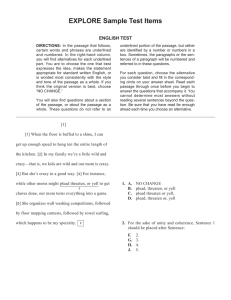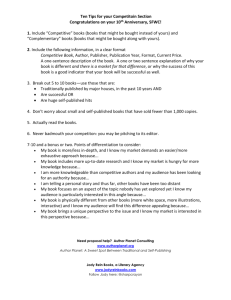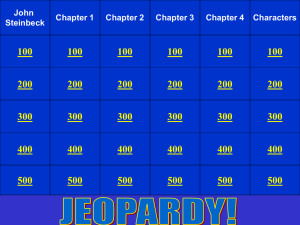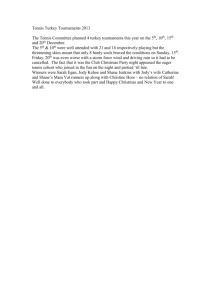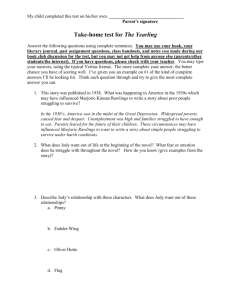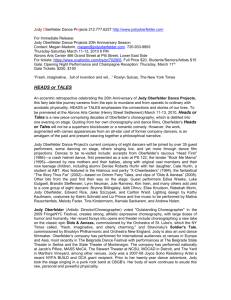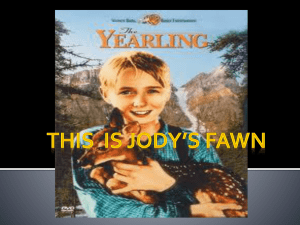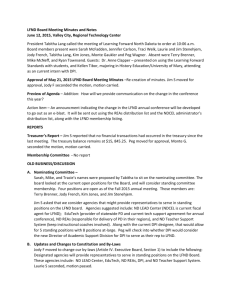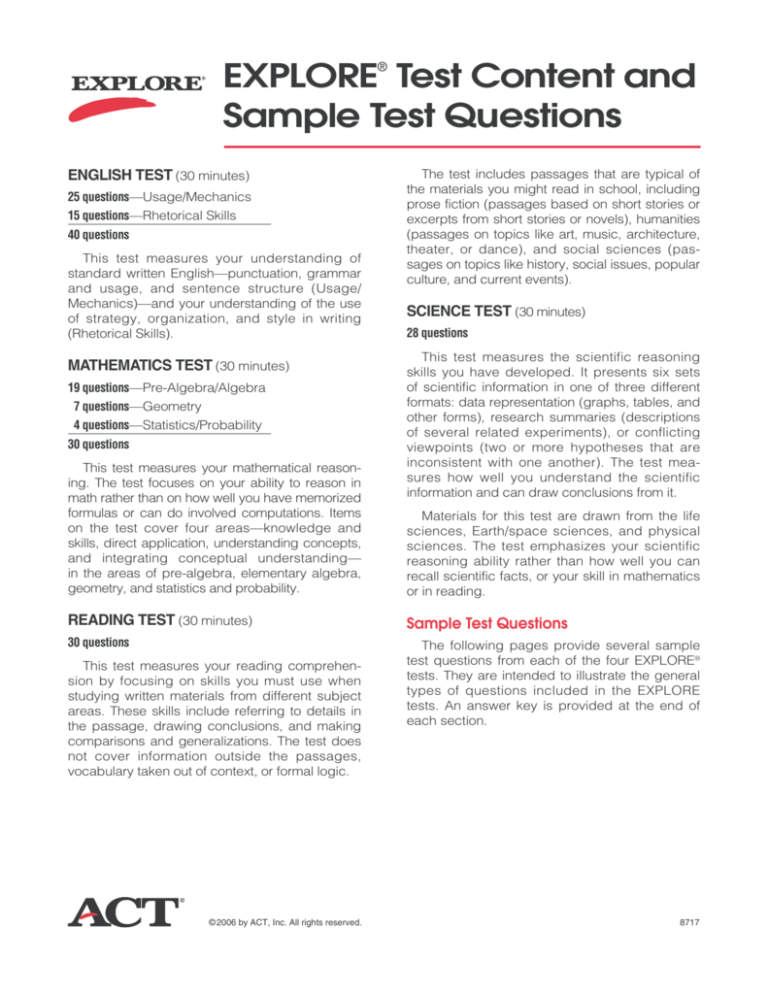
®
EXPLORE Test Content and
Sample Test Questions
ENGLISH TEST (30 minutes)
25 questions—Usage/Mechanics
15 questions—Rhetorical Skills
40 questions
This test measures your understanding of
standard written English—punctuation, grammar
and usage, and sentence structure (Usage/
Mechanics)—and your understanding of the use
of strategy, organization, and style in writing
(Rhetorical Skills).
MATHEMATICS TEST (30 minutes)
19 questions—Pre-Algebra/Algebra
7 questions—Geometry
4 questions—Statistics/Probability
30 questions
This test measures your mathematical reasoning. The test focuses on your ability to reason in
math rather than on how well you have memorized
formulas or can do involved computations. Items
on the test cover four areas—knowledge and
skills, direct application, understanding concepts,
and integrating conceptual understanding—
in the areas of pre-algebra, elementary algebra,
geometry, and statistics and probability.
The test includes passages that are typical of
the materials you might read in school, including
prose fiction (passages based on short stories or
excerpts from short stories or novels), humanities
(passages on topics like art, music, architecture,
theater, or dance), and social sciences (passages on topics like history, social issues, popular
culture, and current events).
SCIENCE TEST (30 minutes)
28 questions
This test measures the scientific reasoning
skills you have developed. It presents six sets
of scientific information in one of three different
formats: data representation (graphs, tables, and
other forms), research summaries (descriptions
of several related experiments), or conflicting
viewpoints (two or more hypotheses that are
inconsistent with one another). The test measures how well you understand the scientific
information and can draw conclusions from it.
Materials for this test are drawn from the life
sciences, Earth/space sciences, and physical
sciences. The test emphasizes your scientific
reasoning ability rather than how well you can
recall scientific facts, or your skill in mathematics
or in reading.
READING TEST (30 minutes)
Sample Test Questions
30 questions
The following pages provide several sample
test questions from each of the four EXPLORE®
tests. They are intended to illustrate the general
types of questions included in the EXPLORE
tests. An answer key is provided at the end of
each section.
This test measures your reading comprehension by focusing on skills you must use when
studying written materials from different subject
areas. These skills include referring to details in
the passage, drawing conclusions, and making
comparisons and generalizations. The test does
not cover information outside the passages,
vocabulary taken out of context, or formal logic.
© 2006 by ACT, Inc. All rights reserved.
8717
ENGLISH TEST
DIRECTIONS: In the passage that follows,
certain words and phrases are underlined
and numbered. In the right-hand column,
you will find alternatives for each underlined
part. You are to choose the one that best
expresses the idea, makes the statement
appropriate for standard written English, or
is worded most consistently with the style
and tone of the passage as a whole. If you
think the original version is best, choose
“NO CHANGE.”
underlined portion of the passage, but rather
are identified by a number or numbers in a
box. Sometimes, the paragraphs or the sentences of a paragraph will be numbered and
referred to in these questions.
For each question, choose the alternative
you consider best and fill in the corresponding circle on your answer sheet. Read each
passage through once before you begin to
answer the questions that accompany it. You
cannot determine most answers without
reading several sentences beyond the question. Be sure that you have read far enough
ahead each time you choose an alternative.
You will also find questions about a section
of the passage, or about the passage as a
whole. These questions do not refer to an
Life in My Family
[1]
[1] When the floor is buffed to a shine, I can
get up enough speed to hang ten the entire length of
the kitchen. [2] In my family we’re a little wild and
crazy—that is, we kids are wild and our mom is crazy.
[3] But she’s crazy in a good way. [4] For instance,
1. A.
B.
C.
D.
while other moms might plead threaten, or yell to get
1
chores done, our mom turns everything into a game.
NO CHANGE
plead, threaten, or yell
plead threaten or yell,
plead, threaten or, yell
[5] She organizes wall washing competitions, followed
by floor mopping contests, followed by towel surfing,
which happens to be my specialty.
2. For the sake of unity and coherence, Sentence 1
should be placed after Sentence:
2
F.
G.
H.
J.
2
2.
3.
4.
5.
[2]
3
We’ve come up with a lot of odd
3. Which of the following sentences, if added at this
point, would most effectively lead the reader from
Paragraph 1 to the description of grocery shopping
in Paragraph 2?
schemes to make grocery shopping fun. Once we
A. Another chore we help Mom with is grocery
shopping.
B. Mom makes us have fun when we do chores.
C. We speak gibberish when we do chores.
D. Grocery shopping is so awful that we have to
speak gibberish just to make it fun.
pretended we were visitors as a future time. Mom
4
acted casual as we pushed the cart through the store
4. F.
G.
H.
J.
NO CHANGE
near
by
from
5. A.
B.
C.
D.
NO CHANGE
had risen
rose
raised
6. F.
G.
H.
J.
NO CHANGE
we
they
she
7. A.
B.
C.
D.
NO CHANGE
the old station wagon must be piled into by us.
we have to pile into our old station wagon.
it is necessary that our old station wagon be
piled into.
8. F.
G.
H.
J.
NO CHANGE
Pretending, we tilted our noses in the air that
To pretend, we tilted, in the air, our noses so
We pretended, it being that by tilting our noses
in the air
speaking gibberish to one another. When a curious
shopper had rose an eyebrow, Mom merely smiled
5
and spoke a greeting in our “future” tongue.
[3]
When chores are done, and when the
weather is nice, I usually head for the beach or a
6
park. Unfortunately, to get to these places,
the old station wagon is piled into by us. The family
7
car looks terrible, and it doesn’t have air-conditioning.
[4]
One hot afternoon, we hatched
an idea to roll up the windows and make
it look as if we had air-conditioning.
Tilting our noses in the air, we pretended we were
8
positively freezing from all the cold air. In spite of
our charade, no one seemed the slightest bit impressed
3
with us. Finally, when Mom couldn’t see through her
perspiration to drive. She insisted we roll down the
9. A.
B.
C.
D.
9
windows.
10
NO CHANGE
drive. She then
drive, she
drive. So she
10. Suppose the writer wanted to add a sentence at this
point to illustrate the dramatic effect of rolling down
the car windows. Which of the following sentences
would most effectively achieve this effect?
Never have I more appreciated
natural air-conditioning. Since then we’ve been a little
less wild and crazy. When we’re tempted to try anoth-
F.
G.
H.
J.
er prank, Mom likes to remind us of the time our halfbaked idea nearly left us that way.
Answer Key
1.
2.
3.
4.
5.
6.
7.
8.
9.
10.
B
J
A
J
D
G
C
F
C
F
4
What a relief!
This time we were a little too wild.
We felt a change.
The car is cooler.
MATHEMATICS TEST
DIRECTIONS: Solve each problem, choose the correct answer, and then use your pencil
to fill in the corresponding circle on your answer sheet.
Do not use too much time on any one problem. Solve the ones you can do quickly; then
return to the others in the time you have left.
You should have a calculator to use for this test. You may use your calculator for any problems you choose, but some of the problems may best be done without using a calculator.
Note: Unless the problem indicates otherwise, you should assume all of the following:
1. Diagrams are NOT necessarily drawn to scale.
2. Geometric figures lie in a plane.
3. The word line indicates a straight line.
4. The word average indicates arithmetic mean. For example, the average of
2, 6, and 7 is 冢
2+6+7
________
冣.
3
Please do NOT write in your test booklet. You may do your figuring on the scratch paper
provided. Your scratch paper will be collected along with your test booklet.
1. 0.003 + 4.1 = ?
A.
B.
C.
D.
E.
3. If 4 + _6x_ = 6, then x = ?
4.003
4.1003
4.103
4.13
4.4
A.
B.
C.
D.
E.
12
16
32
40
60
4. Which of the following is a general expression for
the perimeter of the right triangle below, in miles?
z miles
ile
ym
les
s
2. What is the least expensive shower head on the
chart below that will NOT deliver more than 3
gallons of water per minute (gpm)?
Information from Consumer Reports, “How to Save Water.”
©1990 by Consumers Union of U.S., Inc.
F.
Brand and Model Price
F. Sears 20173
$23
G. Teledyne 5 SM-3U $43
H. Alsons 462PB
$11
J. Alsons 45C
$58
K. Moen 3981
$95
G. 2(x + y)
Maximum gpm
3.4
2.6
2.6
2.7
2.4
x+y+z
y
H. _2x_ · _2_
J.
xy_
__
2
K. xy
5
i
xm
9. The sum of the measures of the 3 angles in a
triangle is 180°. If the measure of one angle in a
triangle is 40°, which of the following could NOT
be the measure of another angle in the triangle?
5. Julia earned $5.20 per hour for 3 _12_ hours and Suki
earned $4.80 per hour for 5 _14_ hours. Who earned
more money and how much more?
A.
B.
C.
D.
E.
Julia earned $7.00 more.
Julia earned $17.00 more.
Suki earned $7.00 more.
Suki earned $17.00 more.
They each earned the same amount of money.
A.
1°
B.
40°
C.
90°
D.
99 _12_ °
E. 141°
6. Tomas bought a new book on sale. It regularly cost
$17.95, but was on sale for 20% off. How much
did the book cost Tomas?
F.
G.
H.
J.
K.
10. Your teacher used the equation x + 19 = 120 when
showing the class how to start to solve the following problem.
$ 3.59
$14.36
$15.95
$17.59
$17.75
Josie gets paid 5¢ for each newspaper she
delivers. She starts with 120 newspapers.
If she has 19 newspapers left when she
finishes, how much will she be paid for
delivering newspapers?
In the teacher’s equation, the variable x represents
the number of:
7. Kane bought a bag of taffy at the candy store. He
got 10 vanilla for his mom, 15 chocolate for his
dad, 6 licorice for his sister, and 22 peppermint for
himself. On the way home, Kane’s sister grabbed
a piece out of the sack without looking. What are
the chances that she pulled out a licorice piece?
A.
_1_
6
B.
_6_
6
C.
6
__
47
D.
6
__
53
E.
47
__
53
F. dollars Josie will be paid.
G. cents Josie will be paid.
H. cents Josie would be paid for delivering the
rest of the newspapers.
J. newspapers Josie has left.
K. newspapers Josie delivered.
Answer Key
1.
2.
3.
4.
5.
6.
7.
8.
9.
10.
8. What is the remainder when 189,540 is divided
by 27 ?
F.
0
G.
7
H.
13
J.
250
K. 7,020
6
C
H
A
F
C
G
D
F
E
K
READING TEST
DIRECTIONS: The passage below is followed by ten questions. After reading the passage, choose the best answer to each question and fill in the corresponding circle on
your answer sheet. You may refer to the passage as often as necessary.
Jody’s father unhooked the door and they went in.
They had been walking toward the sun on the way
down. The barn was black as night in contrast and
warm from the hay and from the beasts. Jody’s
father moved over toward the one box stall. “Come
40 here!” he ordered. Jody could begin to see things
now. He looked into the box stall and then stepped
back quickly.
PROSE FICTION: This passage is adapted from John
Steinbeck’s novel The Red Pony (©1961, 1965 by John
Steinbeck).
35
When the triangle sounded in the morning,
Jody dressed more quickly even than usual. In the
kitchen, while he washed his face and combed back
his hair, his mother addressed him irritably. “Don’t
5 you go out until you get a good breakfast in you.”
A red pony colt was looking at him out of the
stall. Its tense ears were forward and a light of
45 disobedience was in its eyes. Its coat was rough and
thick as an Airedale’s fur and its mane was long and
tangled. Jody’s throat collapsed in on itself and cut
his breath short.
He went into the dining room and sat at the
long white table. He took a steaming hotcake from
the platter, arranged two fried eggs on it, covered
them with another hotcake and squashed the whole
10 thing with his fork.
His father and Billy Buck came in. Jody
knew from the sound on the floor that both of them
were wearing flat-heeled shoes, but he peered under
the table to make sure. His father turned off the oil
15 lamp, for the day had arrived, and he looked stern
and disciplinary, but Billy Buck didn’t look at Jody
at all. He avoided the shy questioning eyes of the
boy and soaked a whole piece of toast in his coffee.
20
50
“He needs a good currying,” his father said,
“and if I ever hear of you not feeding him or leaving
his stall dirty, I’ll sell him off in a minute.”
Jody couldn’t bear to look at the pony’s eyes
any more. He gazed down at his hands for a moment, and he asked very shyly, “Mine?” No one
55 answered him. He put his hand out toward the pony.
Its gray nose came close, sniffing loudly, and then
the lips drew back and the strong teeth closed on
Jody’s fingers. The pony shook its head up and
down and seemed to laugh with amusement. Jody
60 regarded his bruised fingers. “Well,” he said with
pride—“Well, I guess he can bite all right.” The two
men laughed, somewhat in relief. Carl Tiflin went
out of the barn and walked up a side-hill to be by
himself, for he was embarrassed, but Billy Buck
65 stayed. It was easier to talk to Billy Buck. Jody
asked again—“Mine?”
Carl Tiflin said crossly, “You come with us
after breakfast!”
Jody had trouble with his food then, for he
felt a kind of doom in the air. . . . The two men
stood up from the table and went out into the morning light together, and Jody respectfully followed a
25 little behind them. He tried to keep his mind from
running ahead, tried to keep it absolutely motionless.
His mother called, “Carl! Don’t you let it
keep him from school.”
1. After he showed Jody the pony in the barn, Carl
Tiflin went off by himself because he felt:
They marched past the cypress, where a
30 singletree hung from a limb to butcher the pigs on,
and past the black iron kettle, so it was not a pig
killing. The sun shone over the hill and threw long,
dark shadows of the tree and buildings. They
crossed a stubble-field to shortcut to the barn.
A.
B.
C.
D.
7
lonely.
sad.
embarrassed.
amused.
7. The narrator says that Jody finds his father:
2. The inside of the barn is described in the
passage as:
F.
G.
H.
J.
A.
B.
C.
D.
dark and cold.
bright and warm.
airless but bright.
dark and warm.
harder to talk with than Billy Buck.
harder to talk with than his mother.
easier to talk with than Billy Buck.
just as easy to talk to as his mother or Billy
Buck.
3. It can reasonably be inferred from the second
“Mine?” (line 66) uttered by Jody that he:
8. When the narrator says that the two men laughed
when Jody said “Well, I guess he can bite all right”
(line 61), it can reasonably be inferred that the
men felt:
A. won’t curry the horse after school.
B. can hardly believe the pony is his.
C. is wondering how he’s going to afford the
pony.
D. is embarrassed by what his father has done.
F.
G.
H.
J.
4. Jody had trouble seeing in the barn when he first
arrived there because:
F.
G.
H.
J.
he was looking around for his pony.
all he could see was the red pony.
he had just been walking toward the sun.
he had just taken a shady shortcut to the barn.
9. The pony that Jody finds in the stall is characterized
by a:
5. Jody realized he was not headed for a pig killing
because he:
A.
B.
C.
D.
the tension that had built up was relieved.
confused about what to do to the horse.
embarrassed that the horse had been so mean.
surprised that Jody had all his fingers left.
I. rough coat.
II. well-curried mane.
III. gray nose.
ate breakfast with his father and Billy Buck.
saw his father was wearing flat-heeled shoes.
would not be able to miss school.
walked past the singletree and black iron kettle.
A.
B.
C.
D.
6. The narrator’s statement that Jody “tried to keep his
mind from running ahead” (lines 25–26) suggests
that Jody:
F.
is trying not to get too worried or excited about
what might happen.
G. has great respect for his father and especially
for Billy Buck.
H. wants to avoid thinking about how he’ll be
punished for missing school.
J. knew exactly why he had to follow his father
and Billy Buck.
I only
III only
I and II only
I and III only
10. The fact that Jody’s father is described as looking
“stern and disciplinary” (lines 15–16) suggests that
he is:
F.
G.
H.
J.
extremely cruel and mean to Jody.
unwilling to look Jody in the eye.
somewhat distant from Jody.
annoyed at that moment with Jody’s mother.
Answer Key
1.
2.
3.
4.
C
J
B
H
5.
6.
7.
8.
D
F
A
F
8
9.
10.
D
H
SCIENCE TEST
DIRECTIONS: The passages below are each followed by several questions. After reading a passage, choose the best answer to each question
and fill in the corresponding circle on your answer sheet. You may refer to
the passages as often as necessary.
each mineral are listed in the table. Also listed are two
physical properties of the minerals: the density in
grams/cubic centimeter (g/cm3) and the hardness (10 is
the hardest). Hardness is determined by using the minerals to scratch materials of known hardness.
Passage I
The table below lists several minerals and the
chemical elements of which they are made. The common
crystal colors for each mineral and the common uses for
Mineral
Elements
Color
Uses
Density
(g/cm3)
Hardness
Diamond
carbon
clear, blue, yellow
gemstones, abrasives
3.5
10
Corundum
aluminum, oxygen
red, blue
gemstones, abrasives
3.9–4.1
9
Beryl
beryllium, aluminum,
silicon, oxygen
green, blue-green
gemstones, source of beryllium for
airplane alloys
2.7–2.9
7.5
Tourmaline
aluminum, boron, silicon,
oxygen, hydrogen
red, blue
gemstones, high-pressure gauges
3.0–3.3
7
Spinel
magnesium, aluminum,
oxygen
red, yellow,
greenish-brown
gemstones
3.5–4.1
8
Garnet
magnesium, iron, aluminum, silicon, oxygen
red
gemstones, abrasives
3.6–4.3
7.5
Topaz
aluminum, silicon, oxygen, fluorine, hydrogen
clear, yellow,
blue-green
gemstones
3.5
8
Quartz
silicon, oxygen
clear, purple,
yellow
gemstones, pressure gauges, glass,
heat-ray lamps, abrasives
2.7
7
1. According to the data, one could generalize that
minerals used in abrasives:
A.
B.
C.
D.
2. According to the data in the table, which of the
following minerals is the softest?
contain carbon.
have a hardness of 7 or above.
are always red in color.
have a density above 4.0 g/cm3.
F.
G.
H.
J.
9
Corundum
Beryl
Tourmaline
Spinel
4. Many types of sand are made entirely of silicon and
oxygen. Which mineral in the table is most likely
found in those types of sand?
3. According to the data in the table, if you had a blue
gemstone, which of the following could it be?
I. Corundum
II. Tourmaline
III. Quartz
A.
B.
C.
D.
F.
G.
H.
J.
II only
III only
I and II only
II and III only
10
Corundum
Spinel
Topaz
Quartz
The brightly colored males typically own territories with abundant food supplies. They are able to
provide sufficient food for their offspring, whose chances
of survival are excellent.
Passage II
Most newly hatched ducks are covered with a dull
plumage (feathers). When the ducks reach maturity, the
females in some species retain the dull plumage but the
males develop brightly colored plumage. Adult males
remain brightly colored during the fall and winter of each
year. During spring their plumage becomes dull again.
Several theories exist concerning the purpose of
the unique appearance of the male ducks. Two scientists
discuss their theories.
Scientist 1
5. According to Scientist 1, brightly colored males
differ from dull-colored males in that brightly
colored males are:
The distinct color and pattern of the males enable
females to identify males of their own species. Males of
each species have a characteristic plumage that differs
from that of males of other species. Females mate only
with males of their own species. They reject males of all
other species.
A. unhealthy.
B. better able to attract mates.
C. better able to lure away males of the same
species.
D. unable to defend large territories.
Females tend to prefer to mate with those males
within their species that have the brightest plumage.
These selected males tend to have an intimidating effect
on other males, who are inclined to stay away and not
mate with the females.
6. According to Scientist 2, when an intruder
approaches a male duck’s territory, the male duck
may:
In addition, the brightly colored males tend to be
healthier than the less brightly colored males. This gives
them an advantage in attracting females and producing
offspring. Their offspring also tend to be healthy.
F.
G.
H.
J.
hide from the intruder.
sneak away with the offspring.
fly to the nest to attack his mate.
sing loudly and flap his wings at the intruder.
Scientist 2
The distinct color of the male plumage helps them
defend their territories against others of their own species
and own sex. They warn other males to stay out of their
territories by singing and displaying their plumage.
7. All of the following behaviors of male ducks are
consistent with Scientist 2’s viewpoint EXCEPT that
the males:
A. stand guard over the nests.
B. fight the intruders that enter their territories.
C. sit on the eggs while the females guard the
territory.
D. distract intruders away from the location of the
young.
If this theory is correct, the males fight primarily
for territory and not over mates. After mating, the males
stand guard over the females. If an intruder enters the
territory, the males display their bright feathers to distract
the intruder and lure it away. Occasionally the males
may resort to physical combat to defend their territories.
11
10. Scientist 1 would predict that female ducks select
their mates during which of the following seasons?
8. The most important idea that underlies both scientists’ theories about ducks is that the:
F.
G.
H.
J.
F.
external appearance of the male and female
ducks is similar.
G. external appearance of the male and female
ducks is different.
H. males are colored to blend in with their surroundings.
J. females are larger and more striking in color
and patterning than males.
9. The discovery that females prefer to mate with dullcolored males would have which of the following
effects on the theories of Scientists 1 and 2 ?
A. It would lend support to Scientist 1’s theory
only.
B. It would disprove Scientist 1’s theory.
C. It would lend support to Scientist 2’s theory
only.
D. The effect it would have on either scientist’s
theory could not be determined.
12
Spring or summer
Fall or winter
Fall or summer
Spring, summer, or fall
Passage III
Experiment 3
The students added 5 drops of copper sulfate, a
catalyst, to 20 ml of Solution A. When this was mixed
at 22.2° C with 20 ml of Solution B, the average reaction
time for 5 trials was 19 sec.
Several factors affect the rate (how fast the
chemicals react) at which a chemical reaction proceeds.
Reaction rate is affected by the concentrations (relative
amounts per unit volume) of the chemicals being reacted
and the temperature at which the reaction takes place.
The addition of a catalyst (substance that affects the rate
of a reaction without itself being used up) can also
increase the reaction rate.
11. Which of the following indicated that the reaction
was completed in the experiments?
When Solutions A and B (two colorless liquids)
are mixed, a reaction takes place. When the reaction is
completed, the mixture turns dark blue.
A.
B.
C.
D.
Experiment 1
Students mixed 20 ml each of Solutions A and B
at 22.2° C, and stirred the mixture as the reaction
proceeded. The students recorded the time that it took
for the mixture to turn dark blue. This was repeated four
more times. The average time for the five trials was 29
seconds (sec).
Solution A was added to Solution B.
The two solutions were stirred.
The mixed solutions turned clear and colorless.
The mixed solutions turned dark blue.
12. Based on the results of Experiment 2, what is the
relationship, if any, between the temperature of the
mixture and the reaction time?
The students then mixed 20 ml of Solution A,
10 ml of Solution B, and 10 ml of distilled water, all at
22.2° C. The average reaction time for five trials was
71 sec.
F.
As the temperature increases, the reaction time
decreases.
G. As the temperature increases, the reaction time
stays the same.
H. As the temperature decreases, the reaction time
increases then decreases.
J. There is no relationship between the temperature and the reaction time.
The students then mixed 10 ml of Solution A,
10 ml of distilled water, and 20 ml of Solution B, all at
22.2° C. The average reaction time for five trials was
72 sec.
Experiment 2
13. How is the experimental design of Experiment 1
different from that of Experiment 2 ?
The students mixed 20 ml each of Solutions A
and B at three different temperatures. Each time, they
stirred until the reaction was complete. The average
reaction times for five trials are shown in the table.
Temperature (°C)
Time until reaction was
completed (sec)
12.0
58
22.2
29
32.2
15
A. Experiment 1 varies the concentration of the
solutions and Experiment 2 varies the temperature of the mixture.
B. Experiment 1 varies the temperature of the
mixture and Experiment 2 varies the concentration of the solutions.
C. Experiment 1 varies the concentration of the
solutions and Experiment 2 adds a catalyst.
D. Experiment 1 adds a catalyst and Experiment 2
varies the temperature of the mixture.
13
15. Based on the results of Experiments 2 and 3, which
of the following conditions would most likely lead
to the longest reaction time?
14. Based on the results of Experiment 2, one would
predict that if the reaction was repeated at 2° C, the
reaction time would be approximately:
A. A reaction temperature of 50° C and the use of
a catalyst
B. A reaction temperature of 50° C and no catalyst
C. A reaction temperature of 30° C and the use of
a catalyst
D. A reaction temperature of 10° C and no catalyst
F.
8 sec.
G. 30 sec.
H. 60 sec.
J. 116 sec.
Answer Key
1.
2.
3.
4.
5.
B
H
C
J
B
6.
7.
8.
9.
10.
J
C
G
B
G
14
11.
12.
13.
14.
15.
D
F
A
J
D

